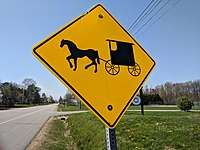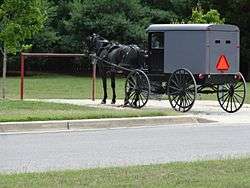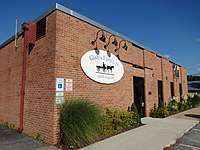Amish in Maryland
The Amish in Maryland maintain a small but well-established population. There have been four Amish communities in the history of Maryland, three of which currently exist. The three Amish communities of Maryland are located in Western Maryland, Southern Maryland, and on the Eastern Shore. Historically, an Amish community also existed in rural Baltimore County, but had disappeared by the 1950s. The Amish communities of Maryland are all inhabited by the descendants of Amish migrants from Pennsylvania. In 2018, Maryland had an Amish population of around 1,575 people.[1]


_04.jpg)

Amish communities
Eastern Shore
The town of Cecilton on Maryland's Eastern Shore is home to a small Amish community that was founded in 1999.[2] Amish families moved to the area from Lancaster County, Pennsylvania because of increasing costs and the declining amount of farmland there.[3]
Southern Maryland Dutch Country
The communities of Mechanicsville and Charlotte Hall in Southern Maryland are home to the largest Amish population in Maryland. The community is well known for its agriculture and its large farmers' market/flea market. The Amish community in the Mechanicsville/Charlotte Hall area consists of 8 church districts and about 1,000 people. The Amish first came to the area in 1939-1940 after some members left the Amish community in Lancaster County, Pennsylvania over a conflict with schooling. The Amish in St. Mary's County maintain dairy and produce farms along with small Amish businesses. There is also an Old Order Mennonite community in the Mechanisville area. In recent years, increasing development has threatened the Amish community.[2][4][5]
Western Maryland
The town of Oakland in Western Maryland is home to an Amish community that consists of a church district of about 70 homes. The Amish community dates back to 1850 and is Maryland's oldest Amish community. The community has become associated with the New Order Amish, with electricity permitted inside of homes.[2] The Amish community in Oakland has a small number of converts to the Amish faith, known as "Seekers", a rarity in the Amish world. There are only between 150 and 200 Amish converts in the United States out of a population around 200,000. The Lancaster County, Pennsylvania Amish have not had a successful convert in over 100 years.[6]
Historic community in Long Green
The unincorporated community of Long Green in Baltimore County was once home to a small Amish community. The Amish community in Long Green was founded in 1833 and lasted for 120 years, before disappearing in the 1950s. The community was founded by Amish from Lancaster County, Pennsylvania, but few settlers moved to the area because Maryland was a slave state at the time. Few Amish people crossed the Mason–Dixon line, due to the Amish opposition to slavery. An Amish meetinghouse was constructed in 1899, but the community never grew large. The community dwindled in size over time, with the last Amish person dying in 1953.[2]
References
- "Amish Population, 2018". Elizabethtown College, the Young Center for Anabaptist and Pietist Studies. Archived from the original on 2019-02-05. Retrieved 2019-05-25.
- "Maryland Amish". Amish America. Retrieved 2019-05-25.
- Guy, Chris (June 27, 2003). "Match made in Cecil County". The Baltimore Sun. Retrieved 2019-05-25.
- "Southern Maryland Dutch Country". WETA. Retrieved 2019-05-25.
- "The Amish of Mechanicsville, Maryland". Amish America. Retrieved 2019-05-25.
- "Amish converts choosing their religion and building roots in oldest settlement". The Guardian. Retrieved 2019-05-25.
External links
| Wikimedia Commons has media related to Amish in Maryland. |
- Amish Country Farmers Market of Easton, Maryland
- Schrock's Country Store
- Amish & Mennonite Community, Visit St. Mary's County